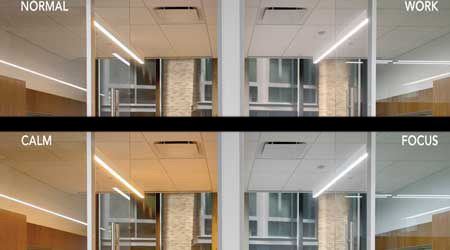 When Michael Best LLC relocated its Washington, D.C., office, the firm identified tunable-white lighting as a highly desirable office lighting feature. The system allowed occupants to select one of four presets in key spaces: “Focus” (5000K), “Work” (4200K), “Normal” (3500K), and “Calm” (2700K), supporting different uses of the spaces.
When Michael Best LLC relocated its Washington, D.C., office, the firm identified tunable-white lighting as a highly desirable office lighting feature. The system allowed occupants to select one of four presets in key spaces: “Focus” (5000K), “Work” (4200K), “Normal” (3500K), and “Calm” (2700K), supporting different uses of the spaces.Tunable White LED Lighting: Questions and Considerations
Tunable white lighting provides a significant new capability for nonresidential general lighting. Benefits include aesthetic, psychological, and potentially physiological gains.
Tunable white lighting provides a significant new capability for nonresidential general lighting. Benefits include aesthetic, psychological, and potentially physiological advantages. White-light tuning can be used to provide apparent cooling or warming to a room, match room finishes and interior decor, suit user preference, simulate daylight or candlelight for mood, match daylight entering the space, signal activity changes in classrooms, support changing displays, and potentially play a role as an entrainer in circadian-supportive lighting strategies. Overall, tunable-white lighting distinguishes a lighting system as both a utility and amenity.
Tunable white luminaires currently have a cost premium for the added engineering and potentially hardware required to provide the capability. Luminaire wiring may be more complex, and the installation may require more robust specification and commissioning. These luminaires may also be less efficacious (lumens per watt) than comparable fixed-output luminaires, though tunable-white luminaires are nonetheless efficient compared to traditional luminaires, and they are listed in the DesignLights Consortium’s Qualified Products List, which is used by utility rebate programs to qualify products.
The LED lighting revolution has entered a new phase where manufacturers are pushing the technology far beyond the benefits of energy efficiency and longevity to explore the technology’s full capabilities and features. Tunable white lighting is a particularly exciting development as it adds a new dimension of lighting control that can serve spaces and users. However, as with any relatively new technology, it requires careful evaluation to ensure solutions are properly matched to applications, resulting in selection of the right products.
Questions to consider
These questions can help facility managers to decide what tunable-white solution works best for a given application and to evaluate products.
- Who are the intended users of the tunable-white lighting? What is the purpose of the tuning in the space?
- How smooth do the changes in intensity and CCT have to be?
- How precise does the dimming have to be? What is the dimming and color tuning range? Does the product dim to OFF, and if so, how does it do that?
- How fast do the lights need to respond to the control input?
- What’s the likelihood of flicker during dimming?
- How does the energy code treat tunable-white luminaires? For example, the latest version of the California Title 24 energy code provides a 25 percent calculated reduction of luminaire wattage for “small aperture” LED luminaires that meet specific size requirements, have a minimum tunable range, and include tunable controls. An additional energy credit is provided for using tunable-white or dim-to-warm lighting in hospital nurseries and nursing stations.
- Are all components compatible and matched to the application characteristics?
- Is the solution standalone or will it operate as part of a larger control system? Where will the controller (lighting intelligence, or microprocessor) reside (wallbox, handheld, software)? Does the system need to be integrated with other systems?
- How simple or sophisticated should the interface be? If a GUI, is it intuitive to use? How important is repeatability, which might require scene setting and recall?
Answering these questions will help discover the right solution for the space. A mockup is recommended, which allows personal evaluation. The effect of personally seeing what’s possible with tunable-white is often powerful.
Craig DiLouie is education director for the Lighting Controls Association.
Related Topics:














